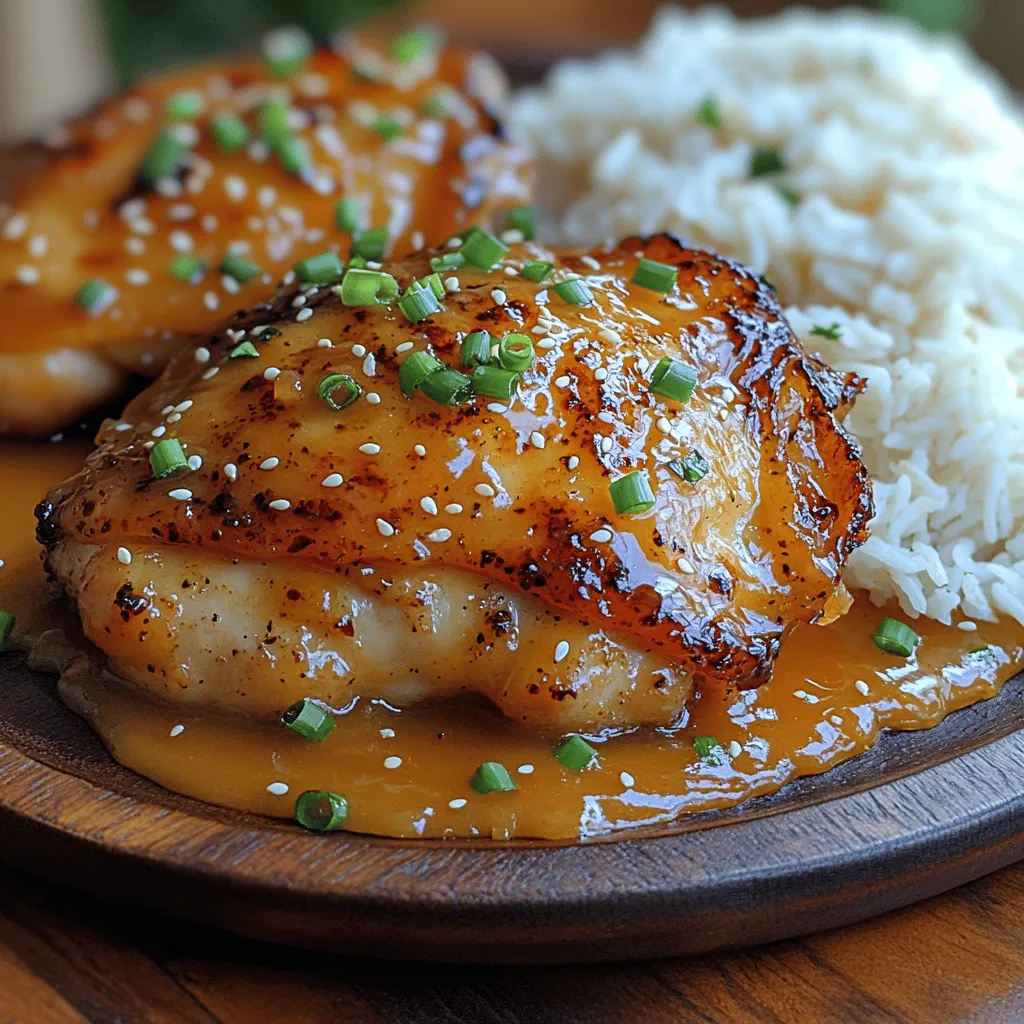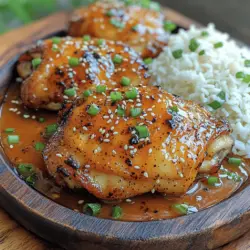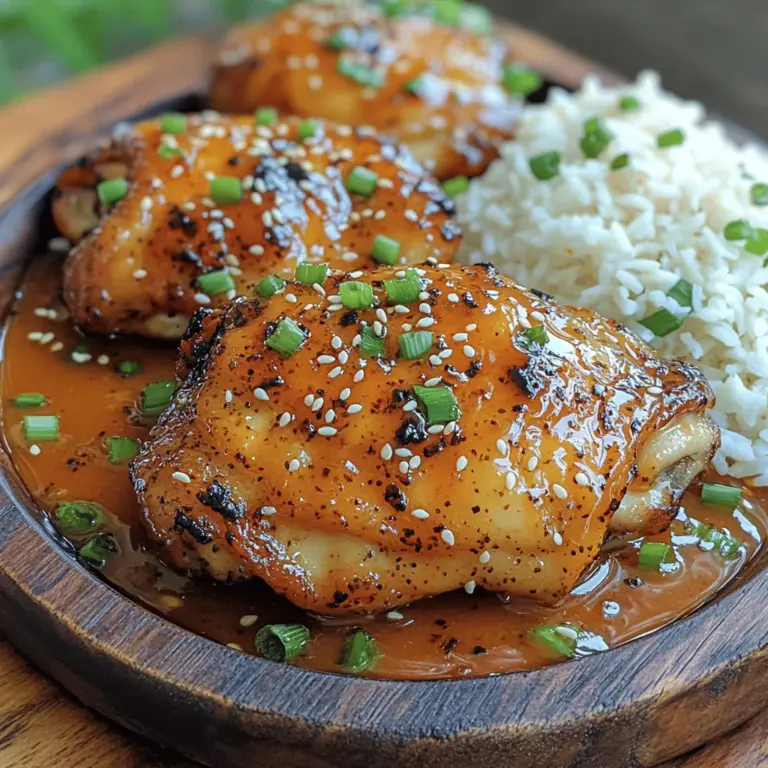The Ginger Orange Glazed Chicken is a delightful fusion of tangy citrus and warm ginger that will awaken your taste buds while providing a comforting, satisfying meal. This dish not only pleases the palate but also offers a vibrant presentation that can elevate any dinner table. The combination of succulent chicken thighs coated in a zesty orange glaze infused with the aromatic warmth of ginger creates an unforgettable dining experience. Whether you’re preparing a quick weeknight dinner or planning to impress guests, this recipe is a must-try for anyone looking to add a touch of zest to their culinary repertoire.
Understanding the Ingredients
To master the art of Ginger Orange Glazed Chicken, it’s essential to understand the role each ingredient plays in building flavor and texture. Let’s break down the main components of this recipe:
Chicken Thighs
For this dish, boneless, skinless chicken thighs are the preferred choice. Unlike chicken breasts, thighs offer a richer flavor and remain tender and juicy even when cooked at higher temperatures. The extra fat in the thighs helps to keep the meat moist, ensuring that every bite is packed with flavor. Additionally, they are more forgiving than chicken breasts, which can easily dry out if overcooked. When selecting chicken thighs, look for ones that are plump and have a vibrant, pink color to ensure freshness.
Fresh Orange Juice and Zest
Using fresh orange juice and zest is crucial for achieving the best flavor in your glaze. Store-bought orange juice often lacks the bright, vibrant taste found in freshly squeezed juice. The zest, or the outer peel of the orange, contains essential oils that add a fragrant aroma and a burst of citrus flavor. When preparing your ingredients, make sure to zest the orange before juicing it, as this will make the process easier. The combination of juice and zest in the glaze creates a perfect balance of sweetness and acidity, enhancing the overall dish.
Soy Sauce and Honey
Soy sauce and honey are two key ingredients that contribute depth and sweetness to the glaze. The soy sauce adds an umami flavor, which complements the brightness of the orange and the warmth of the ginger. Honey, on the other hand, provides a natural sweetness that balances the tanginess of the citrus. When combined, these ingredients create a rich, complex glaze that caramelizes beautifully when cooked, adding a glossy finish to the chicken.
Ginger and Garlic
Ginger and garlic are aromatic elements that elevate the flavor profile of the dish. Fresh ginger adds a spicy warmth that pairs beautifully with the sweetness of the honey and the acidity of the orange. It’s best to use fresh ginger for this recipe, as it delivers a more intense flavor compared to dried ginger. Garlic adds a savory note that rounds out the dish. Together, these ingredients create a harmonious blend of flavors that make this dish truly irresistible.
Cornstarch
Cornstarch plays an essential role in achieving the perfect glaze consistency. When combined with liquid, cornstarch acts as a thickening agent, creating a glossy sauce that clings beautifully to the chicken. It’s important to mix the cornstarch with a bit of cold water to create a slurry before adding it to the glaze. This step ensures that the cornstarch incorporates smoothly without clumping, resulting in a velvety sauce that enhances the overall presentation.
Garnishes
While the main components of the dish are vital, garnishes like sesame seeds and green onions can significantly impact presentation and flavor. Sesame seeds add a delightful crunch and nutty flavor, while finely chopped green onions provide a fresh, vibrant finish to the dish. Not only do these garnishes enhance the visual appeal of the plate, but they also contribute additional layers of flavor that make each bite more exciting.
Step-by-Step Preparation Guide
Now that we’ve explored the key ingredients, it’s time to dive into the preparation of Ginger Orange Glazed Chicken. Follow these detailed instructions to ensure success in your cooking endeavors.
Preparing the Chicken
Begin by preparing the chicken thighs. Start with 1 to 1.5 pounds of boneless, skinless chicken thighs. Pat the chicken dry with paper towels to remove excess moisture, which will help achieve a better sear. Season both sides of the chicken generously with salt and pepper. This simple seasoning is crucial as it enhances the natural flavors of the meat and provides a solid foundation for the glaze. If you have time, let the seasoned chicken rest at room temperature for about 15-20 minutes. This helps the chicken cook more evenly.
Cooking the Chicken
To cook the chicken, heat a large skillet over medium-high heat and add a tablespoon of oil—canola or vegetable oil works well due to their high smoke points. Once the oil is hot, carefully add the chicken thighs to the skillet, ensuring not to overcrowd the pan. Overcrowding can cause the chicken to steam rather than sear, preventing that desirable golden-brown color.
Cook the chicken for about 5-7 minutes on one side without moving it. This will allow for a nice sear to develop. Flip the chicken and reduce the heat to medium. Cook for an additional 5-7 minutes or until the chicken reaches an internal temperature of 165°F (75°C). Use a meat thermometer to ensure accuracy. Once cooked, transfer the chicken to a plate and cover it loosely with aluminum foil to keep it warm while you prepare the glaze.
Making the Glaze
Now it’s time to create the ginger-orange glaze that brings this dish to life. In a small mixing bowl, combine 1/2 cup of freshly squeezed orange juice, the zest of one orange, 1/4 cup of soy sauce, and 1/4 cup of honey. Add in 1 tablespoon of freshly grated ginger and 2 cloves of minced garlic. Whisk the ingredients together until well combined.
In a separate small bowl, mix 1 tablespoon of cornstarch with 2 tablespoons of cold water to create a slurry. This step is essential for achieving a smooth glaze without lumps. Once the glaze mixture is combined, stir in the cornstarch slurry and mix well.
Thickening the Sauce
To thicken the glaze, return the skillet to medium heat. Pour the glaze mixture into the skillet, scraping up any browned bits from the bottom—these bits add depth and flavor to your sauce. Allow the glaze to come to a gentle simmer, stirring frequently. As the mixture heats, it will begin to thicken. This should take about 2-3 minutes. Keep an eye on it, as you want a syrupy consistency that coats the back of a spoon without being overly thick.
Glazing the Chicken
Once the glaze has reached the desired consistency, return the cooked chicken thighs to the skillet. Toss the chicken in the glaze, ensuring that each piece is thoroughly coated. The residual heat from the chicken will help absorb the flavors of the glaze, creating a beautifully caramelized finish. Cook for an additional 1-2 minutes, allowing the glaze to cling to the chicken and develop a rich, glossy appearance.
With these steps complete, your Ginger Orange Glazed Chicken is nearly ready to be served. The combination of tender chicken enveloped in a sweet and tangy glaze, topped with aromatic garnishes, promises a dish that is both visually appealing and bursting with flavor. Stay tuned for further guidance on plating and serving this delightful meal, along with tips to elevate your culinary experience even more.

Serving Suggestions
To elevate your Ginger Orange Glazed Chicken into a complete meal, consider pairing it with sides that complement its vibrant flavors. Here are some excellent suggestions:
Suggested Sides
1. Steamed Jasmine Rice: The light, fragrant qualities of jasmine rice serve as a perfect canvas for the rich ginger orange glaze. The rice will absorb the sauce beautifully, making for a delightful bite every time.
2. Stir-Fried Vegetables: A mix of bell peppers, snap peas, and broccoli stir-fried in sesame oil adds both color and crunch to your plate. The crispness of the vegetables balances the tenderness of the chicken while also adding nutritional value.
3. Quinoa Salad: For a more health-conscious option, serve your glazed chicken with a quinoa salad mixed with diced cucumbers, cherry tomatoes, and a light lemon vinaigrette. The nuttiness of quinoa pairs well with the sweet and spicy notes of the glaze.
4. Roasted Sweet Potatoes: The natural sweetness of roasted sweet potatoes complements the ginger and orange flavors beautifully. A sprinkle of cinnamon can enhance this side dish even further, creating a harmonious blend of flavors.
5. Cabbage Slaw: A fresh cabbage slaw dressed in a tangy rice vinegar and sesame oil dressing brings a refreshing crunch to the meal. The acidity of the slaw contrasts nicely with the sweetness of the chicken glaze.
Beverage Pairings
To enhance your dining experience, consider the following beverage pairings:
1. Chardonnay: A lightly oaked Chardonnay complements the richness of the chicken while its acidity brightens up the flavors of the glaze.
2. Ginger Beer: For a non-alcoholic option, ginger beer provides a spicy kick that echoes the ginger in the dish. Serve it chilled, garnished with a slice of lime for an extra zing.
3. Green Tea: A hot cup of green tea can cleanse the palate and enhance the meal’s overall health benefits. Its subtle earthy tones balance the sweetness of the ginger orange glaze.
4. Sparkling Water with Citrus: For a refreshing palate cleanser, sparkling water infused with slices of orange or lemon can add a touch of zest to the meal without overpowering the main dish.
Variations on the Recipe
This Ginger Orange Glazed Chicken recipe can easily be adapted to meet different dietary preferences:
– Vegetarian Option: Substitute the chicken with tofu or tempeh. Marinate and glaze the tofu or tempeh the same way to achieve a similar flavor profile. For a heartier option, consider using portobello mushrooms, which have a meaty texture.
– Gluten-Free Adaptation: Ensure that the soy sauce used in the glaze is gluten-free. Tamari is an excellent alternative that provides the same depth of flavor without gluten.
– Paleo Version: For a paleo-friendly dish, swap out soy sauce for coconut aminos and use honey as the sweetener in the glaze. Serve the chicken with a side of cauliflower rice for a low-carb option.
Cultural Significance of Ginger and Orange in Cuisine
Ginger and orange are not just delicious; they also carry rich culinary histories and health benefits that enhance their appeal in global cuisine.
Ginger in Global Cuisine
Ginger is a staple ingredient in many cultures around the world. Originating from Southeast Asia, it has made its way into various dishes across different cuisines. In Indian cooking, ginger is often used in curries and chai, lending warmth and spice. Chinese cuisine incorporates ginger in stir-fries and soups, known for its digestive benefits. In Western cooking, ginger is celebrated in baked goods like gingerbread and cookies, showcasing its versatility.
Orange as a Flavoring Agent
Orange is equally versatile, used in both sweet and savory dishes. In Mediterranean cuisine, orange zest adds brightness to salads and meat dishes. In Latin American cooking, it is often employed in marinades and salsas, offering a citrusy punch. The sweet and tangy profile of orange can elevate sauces and desserts alike, making it a beloved ingredient in kitchens worldwide.
Health Benefits
Both ginger and orange are packed with health benefits. Ginger is renowned for its anti-inflammatory properties and its ability to soothe digestive issues. It also contains antioxidants that can improve overall health. Oranges are rich in vitamin C, which boosts the immune system, and their fiber content aids digestion. Together, they create not only a delicious dish but also a nutritious one.
The Art of Plating
Creating a visually appealing presentation of your Ginger Orange Glazed Chicken can enhance the dining experience. Here are some tips to make your plate stand out:
Techniques for Presenting the Dish
1. Choose the Right Plate: A white or neutral-colored plate can help the colors of your dish pop. Opt for a slightly larger plate to give the food space to breathe.
2. Layering: Start with a base of your chosen side, such as jasmine rice or quinoa salad. Place the glazed chicken on top, allowing the glaze to drizzle down the sides.
3. Garnishing: Fresh herbs like cilantro or parsley can add a pop of green, while slices of orange or a sprinkle of sesame seeds can enhance the visual appeal. A few chili flakes can provide a hint of color as well.
The Significance of Garnishes
Garnishes not only improve aesthetics but can also add additional layers of flavor. For example, a sprinkle of chopped scallions can introduce a mild onion flavor, while a wedge of orange can provide a fresh burst when squeezed over the dish.
Creating a Balanced Plate
A well-balanced plate should consider color, texture, and portion size. Aim for a variety of colors from vegetables, grains, and protein. This not only makes the dish visually appealing but also ensures a range of nutrients in your meal. Consider adding a splash of color with some fresh vegetables on the side, and ensure that the textures of your sides complement the tenderness of the glazed chicken.
Conclusion
The Ginger Orange Glazed Chicken is not just a meal; it is an experience that combines fresh ingredients, vibrant flavors, and cultural significance into one delightful dish. By carefully following the preparation steps and understanding the key components of the recipe, home cooks can create a stunning meal that is sure to impress. Whether for a casual family dinner or a festive gathering, this dish embodies the joy of cooking and sharing food with loved ones. Enjoy the burst of flavors and the satisfaction that comes from creating something special in your kitchen.


